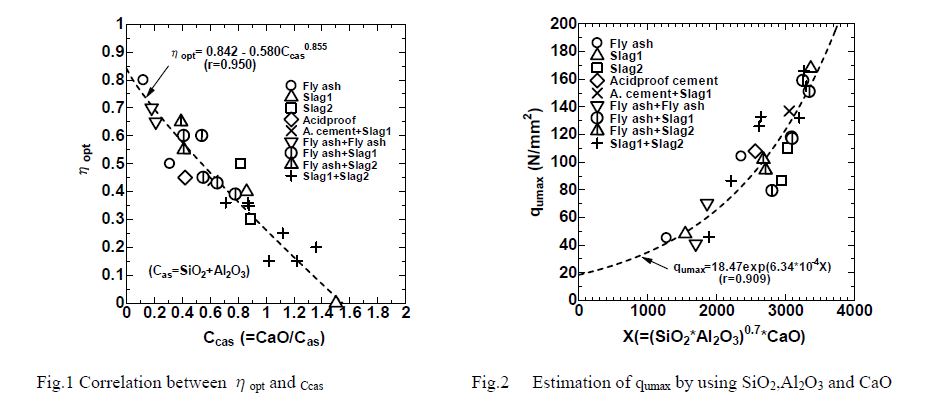Video Article Open Access
Methods for Production and Strength Diagnosis of Geopolymers using Industrial By-Products such as Fly Ash, Steel Making Slags and Garbage Melting Furnace Slags
Tatsuya Koumoto
Saga University, Saga, 840-8502, Japan
Vid. Proc. Adv. Mater., Volume 1, Article ID 2020-0811 (2020)
DOI: 10.5185/vpoam.2020.0811
Publication Date (Web): 06 Aug 2020
Copyright © IAAM
Graphical Abstract

Abstract
More than 60 billion kgs of industrial by-products such as fly ash, steel making slags, and garbage melting furnace slags are generated every year in Japan. Almost all of them seem to have been effectively used in mixtures with cement according to their chemical and mechanical properties in the field of civil work. Fly ash and slags can be used to create geopolymers in a process that emits less carbon dioxide than in the cement making process. This reduction in CO2 emission is important because CO2 is one of the substances known to contribute to global warming. In the future, further uses of these fly ash and slags must be explored. The chemical mechanism for hardening composite materials by mixing aluminosilicate binders, such as fly ash, and slags with alkaline activators, such as liquid NaOH and sodium silicate, is known as a geopolymer reaction. The hardened composite material is called geopolymer. Geopolymers are produced by mixing two components of solid binders like fly ash, slags, etc. and liquid activators like NaOH, KOH, sodium silicate and so on. Geopolymers have recently been developed to be used as a replacement for Portland cement concrete. The development of high compressive strength geopolymer using fly ash and slags will strongly contribute to the fields of construction, geotechnical engineering, and architecture. This lecture introduces the research to clarify the method for production, the strength diagnosis of geopolymers, and the chemical and mechanical characteristics of geopolymers by mixing fly ash and slags as binders with 48% NaOH (18 mol/L) and sodium silicate (Na2・nSiO2 , n=3.2) as activators. The research results are summarized as (a) To produce the high compressive strength geopolymers, slags has to be ground to be as fine as possible, (b) The compressive strength qu becomes generally the maximum value (qumax ) when the weight ratio, w , of the mixed solutions of NaOH and sodium silicate to the binder is 0.4 (= wopt : the optimum value of w yielding qumax ), regardless of the type of the binder, (c) There is an optimum value, ηopt (the weight ratio of NaOH to sodium silicate) yielding qumax for each binder, (d) The η opt is well correlated with the factor Cas(=Al2O3 +SiO2 ) as: ηopt = 0.0157Cas – 0.414 and is also well correlated with the factor Ccas (= CaO/Cas) as: ηopt = 0.842 – 0.580Ccas0.855 (see Fig.1) and the value η opt for an arbitrary binder necessary to manufacture the high compressive strength geopolymer is calculated by above either equation, (e) The factor Ccas is effective to diagnose the high compressive strength geopolymers and the binders having the factor Ccas in the range of 0.5 –1.2 (η opt =0.3 – 0.6) yields high compressive strength geopolymers with qumax = 100 -168 N/mm2, (f) The volume shrinkage ratio ΔV/V is generally less than 2% when Ccas is smaller than 0.9, (g)The density ρ t of geopolymers is clearly expressed as a function of the factor Ccas as: ρ t = 2231.5 + 171.7lnCcas, and (h) The qumax can be fairly estimated by using three main chemical compositions of binder: SiO2, Al2O 3 and CaO as: qumax = 18.47exp(6.34×10-4X), where X = (SiO2 ×Al2O3)0.7×CaO (see Fig.2).
Keywords
Chemical composition, Compressive strength, Fly ash, Geopolymer, Slag.
Acknowledgement
The author grateful to Maruwa Giken for preparing ground solid waste incinerator slags. The author is also grateful to Kyuden Sangyo, Shunan Works, Nissin-Steel, and Nippon Steel & Sumikin Slag Products for contributing coal-fired powder plant ash, stainless manufactured slag, and ground granulated blast slag, respectively.
References
- Buchwald, A. 2006. “What are geopolymers? Current state of research and technology, the opportunities they offer, and their significance for precast industry.” Betonwerk und Fertigteil-Technik. 72(7) :42-49.
- Budth, C. D., and N. R. Wahhade. 2014. “Effect of morarity on compressive strength of geopolymer mortar.” Int. J. Civ. Eng. Res. 5(1): 83-86.
- Davidovits, J. 1991. “Geopolymers inorganic polymeric new materials.” J. Therm. Anal. 37(8): 1633-1656. https://doi.org/10.1007/BF0191293.
- Ikeda, K., and A. Mikumi. 2006. “Recent development of geopolymers from viewpoint of carbon dioxide emission and waste management problem.” Trans. MRS-J. 31: 319-324.
- Koumoto, T. 2019. “Production of High Compressive Strength Geopolymers Considering Fly Ash or Slag Chemical Composition.” J. of Mater. Civ. ASCE, 31(18), 06019006
Biography
Tatsuya Koumoto has an educational background as: 1967 Bachelor’s degree, 1969 Master’s degree and 1978 Ph.D given by Kyushu University, Fukuoka, Japan. His academic appointments are as: 1972-1978 Assistant Professor of Kyushu University, 1978-1992 Associate Professor of Saga University, Saga, Japan, 1992-2009 Professor of Saga University, 2009 retired from Saga University, 2009-now Professor Emeritus of Saga University. He has visited Technical University of Nova Scotia, Canada as Research Associate (1984-1985), Oxford University as Academic Visitor (1997), Kasetsart University, Thailand as Visiting Researcher (2007) and Asian Institute of Technology, Thailand as Visiting Professor (2010). He is now a director of Geopolymer Research Laboratory, Saga, Japan. His research activities include physical and mechanical properties of soft soil, theory and practice of cone penetration testing, bearing capacity of pile foundations, design and construction of box type foundation for soft ground and development of high compressive strength geopolymers using industrial by-products such as fly ash, steel making slags and garbage melting furnace slags. He has more than 130 technical papers in various international journals, conferences and symposia. He has 3 patents on (1) Box foundation method for soft ground, (2) Production, strength diagnosis and strength improvement method for geopolymer compositions and (3) Development of impervious material by mixing soil and geopolymer for irrigation pond.
Video Proceedings of Advanced Materials

Upcoming Congress



